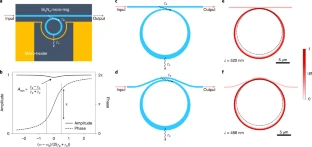Phys.org November 22, 2021
Currently, the two most suitable materials are silicon nitride and lithium niobate. While both are highly transparent in the visible range, neither one provides very much tunability. A team of researchers in the US (Columbia University, Tufts University) developed a way to dramatically reduce both the size and the power consumption of a visible-spectrum phase modulator, from 1 mm to 10 microns and from tens of mW for π phase tuning to below 1 mW. The key to their solution was to use an optical resonator and to operate it in the strongly over-coupled regime. In a comparative study of adiabatic micro-rings and conventional micro-rings 63% of the adiabatic micro-rings kept operating in the strongly over-coupled regime. They exhibit improved robustness against fabrication variations, less than one-third of the power is needed to thermo-optically align the resonances of the adiabatic micro-rings across the chip to the laser frequency…read more. TECHNICAL ARTICLE

Micro-resonator operating in the strongly over-coupled regime for phase modulation. Credit: Nature Photonics (2021)